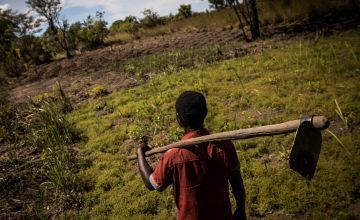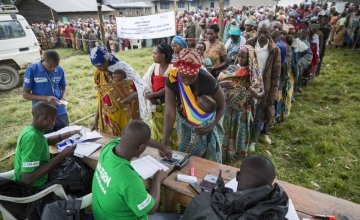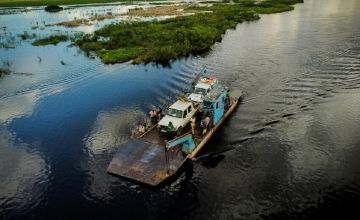
Knowledge Hub
For decades, one of the world’s deadliest, longest-running crises has been unfolding in the Democratic Republic of Congo. Yet you’ve probably heard almost nothing about it.
The scene for one of the worst-ever civil wars in African history, the Democratic Republic of Congo has moved from the national conflict of the late 1990s to a series of smaller, localised conflicts focused in specific regions and centred on land, resources, and power. On a continent that has the most displaced people in the world, the DRC is the country with the most displaced people, with nearly 5.5 million people away from home.
Crisis is not new in this country, but the nature of its particular humanitarian emergency has changed over time.
Here are 5 things to know about the current DRC crisis as we end 2021 and enter 2022.
1. The DRC is one of the world’s poorest countries, but has one of the largest reserves of potential wealth
Paradoxically, the DRC’s potential wealth is vast. The country has nearly 200 million acres of cultivable land. It’s also home to large reserves of diamonds, gold, copper, cobalt, zinc, and coltan, which is used in mobile phones and other electronics.
Despite these economic advantages, DRC is one of the world’s poorest countries, ranking 175 of 189 on the 2021 UN Human Development Index, with 73% of its population living in extreme poverty. The roots of this paradox lie in centuries of exploitation and violent plundering by colonizers, leaders, private interests, neighboring countries, and internal warring factions.

2. A legacy of crisis and conflict has led to the current, escalated situation
The DRC has endured decades of multiple, overlapping crises. The impact of King Leopold II of Belgium’s colonization is still felt in the country and its ongoing series of violent conflicts. As we mentioned above, that conflict has become more localised. However, that does not lessen its damage.
For example, the country’s southern Kasai region became a stronghold of the country’s main political opposition party in 2012. Chiefs hold a large amount of power and administrative control in DRC (even though they aren’t political positions), and Jean-Pierre Pandi assumed this role in Kasai that year. However, in 2016, Pandi was killed during clashes between his followers and government forces. This led to a full-scale conflict erupting, one that displaced more than 1.4 million people.
Sporadic waves of fighting across many parts of the country make the DRC a complex and challenging humanitarian situation. Over 5 million Congolese people are internally displaced within the country, representing the third largest population of internally displaced people (IDPs) in the world. In the first half of 2020 alone, there were an estimated 1,427,000 new displacements associated with conflict.
3. There are other challenges besides conflict
Even in parts of the country where violence has ceased, undoing the cost of conflict is not an easy task. “Tanganyika has stabilised over the last two or three years,” explains current Concern DRC country director Russell Gates. “Now it’s in that phase of, OK, the conflict has stopped for large parts of this province, but there’s no food, there’s no investment, there’s nothing. It was all destroyed, or it’s all gone.”
This is the last part of the cycle of conflict, and one that’s easily forgotten: Any stability that comes with a ceasefire will be short-lived if people are not able to recover their lives and livelihoods.
There are challenges here, too. The DRC is comparable in size to all of Western Europe. However, its vast geography is characterised by low population density and expansive forests. According to the UN, there are only about 1,400 miles of paved road in DRC, and just over 9,000 miles of unpaved road (which are frequently impassable during the rainy season). Most of the country is literally off the grid: Only 10% of Congolese have access to electricity, a figure that drops to only 1% in rural areas, where most of the country lives.
More than half of the country — a figure as high as 50 million — lacks access to clean water. This is especially worrying in the face of several epidemics in recent years including the world’s second-largest Ebola outbreak, measles, malaria, and cholera. The country is now grappling with Covid-19, as well as another increasingly severe epidemic: hunger.
4. Many of these individual crises have added up to a potential famine

Renewed armed conflict continued in 2021 to significantly disrupt livelihoods in several regions of the DRC. Covid-19 measures and the virus itself also had a significant impact on food prices, and country-wide economic decline has decreased the purchasing power of households. The DRC is now the biggest food security crisis in the world, with over 27 million people facing severe or acute food insecurity. Some areas, like Tanganyika province, are facing extreme food insecurity, bordering on a level where preventable deaths related to famine and starvation are likely to occur.
This is our last chance to turn the situation around, and we’ve had plenty of warnings in recent years: In 2017, World Food Programme Executive Director David Beasley raised the alarm, when more than 3 million people in the country’s Greater Kasai region were severely food insecure, struggling to feed themselves and in urgent need of assistance: “What the brave people I met over the last few days want most of all is peace — peace to be able to grow their own food, to rebuild their lives and to build a brighter tomorrow for their children. It’s a simple, powerful message.”
5. Despite decades in crisis, very few people know what’s going on
But that simple, powerful message is struggling to be heard in the current climate. Former Concern DRC country director Gregoire Borgoltz explained the challenges being felt at the end of the last decade after more than 60 years of a protracted crisis: “There are so many other very visible crises in the news that it’s hard to keep people interested in countries that have been plagued by conflict for decades.”
This is what’s known as “crisis fatigue.” Although conflicts continue to break out in the DRC (and other countries suffering these sorts of complex emergencies), they don’t always make the headlines. When violence broke out in Kasai in 2016, there was little media interest in it until two UN investigators were murdered in March, 2017.
Concern is one of several national and international organisations that have been flagging the deteriorating situation in DRC for quite some time. Four years ago, the UN decided to declare a Level 3 (L3) emergency — the highest alert level — in three provinces in an effort to attract attention. These methods, however, are not 100% successful. Earlier in 2021, leaked reports from the UK suggested that the country’s aid to the DRC could be cut by up to 60%.
What can be done?

One rising trend that Gregoire Borgoltz noted is that donors are now pushing their partners to get more quickly to where the greatest needs are, and agencies are forced to propose innovative approaches. For example, Concern has created mobile Rapid Response teams to respond to recent displacements across the country.
In 2020, these teams responded to five displacement crises, providing emergency support to households fleeing conflict or natural disasters and helping them to buy food, access clean water, and obtain hygiene kits. In total, 159,000 recently displaced people were supported by Concern. Examples like this, more coherent advocacy messages and a more targeted humanitarian response will hopefully spur more donors to action.
What you can do.
- Read, watch, and listen to reportage on the DRC crisis, and subscribe to the outlets, like The New Humanitarian, that are providing accurate and ethical reporting on the crisis. If your outlet of choice is falling behind in their commitment to this topic, write a letter to the editor. As the Covid-19 pandemic has shown, what happens in one country can affect the entire world, and if the crisis in the DRC intensifies, it will only become more relevant to us all.
- Finally, you can support Concern, who have a proven track record in emergency response and navigating complex crises while still achieving results.
With your help, we can provide the therapeutic food that malnourished children desperately need to survive and recover, and help provide families with food to help prevent malnutrition in the long-term too.
Other ways to help
Donate now
Give a one-off, or a monthly, donation today.
Join an event
From mountain trekking to marathon running, join us for one of our many exciting outdoor events!
Buy a gift
With an extensive range of alternative gifts, we have something to suit everybody.
Leave a gift in your will
Leave the world a better place with a life-changing legacy.
Become a corporate supporter
We partner with a range of organisations that share our passion and the results have been fantastic.
Create your own fundraising event
Raise money for Concern by organising your own charity fundraising event.





